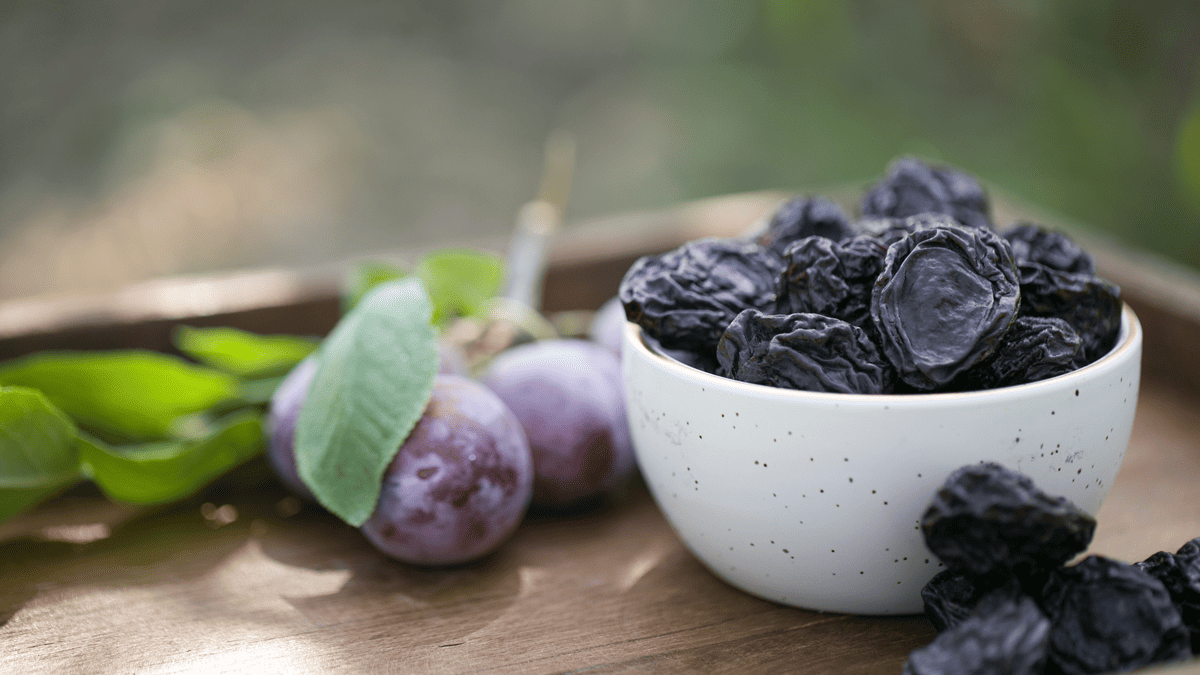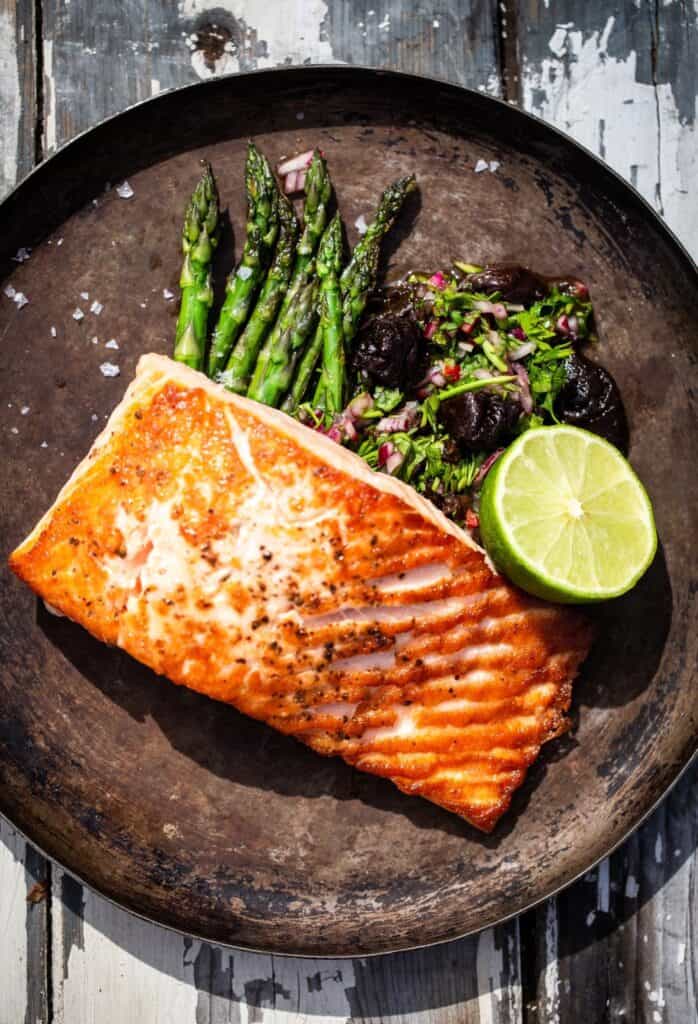
Exploring the Anti-Inflammatory Benefits of Prunes
When you think about anti-inflammatory foods, which foods come to mind? Most people would include foods like salmon, blueberries, walnuts, ginger and turmeric at the top of their lists. But did you know prunes have been shown in studies to lower inflammatory markers? Prunes contain several compounds that are anti-inflammatory and have antioxidant properties, making California Prunes a smart addition when it comes to an overall anti-inflammatory nutrition strategy.
By Melissa Groves Azzaro, RDN, LD
What Is Inflammation and How Does It Impact Health?
Inflammation is a natural process in the body in which the immune system responds to an injury or an infection. Acute inflammation protects the body and typically manifests as short-lived swelling, heat and pain, aimed to heal the underlying issue. However, sometimes inflammation can become chronic, which can last months or years after the initial trigger is gone and can cause additional problems. Chronic inflammation can stem from underlying conditions that increase inflammatory cytokines in the body or be the result of dietary and lifestyle choices.
Chronic inflammation has been linked to several chronic conditions, including cardiovascular disease, immune conditions (allergies, asthma, autoimmune conditions), metabolic conditions, gastrointestinal conditions (like ulcerative colitis and Crohn’s disease), mental health and mood disturbances, Alzheimer’s disease, bone loss, and more.1 There are several ways a health professional can measure inflammation in the body, such as looking at c-reactive protein levels or doing a complete blood count, which gives information about the number of different cells in the blood.
Anti-Inflammatory Nutrition Strategies
Research supports following a variety of eating patterns and consuming specific foods and plant compounds that can lower inflammation. A Mediterranean-style diet, for example, is one pattern that has been linked to lower inflammatory markers and a lower prevalence of diseases linked to chronic inflammation.2 However, other ways of eating such as traditional Asian diets and Nordic dietary patterns may also be beneficial.3 From these healthful eating patterns, we can glean some anti-inflammatory strategies.

Include Foods High in Antioxidants
Antioxidants are compounds in foods that combat oxidative stress in the body. Antioxidants include vitamin C (citrus, bell peppers), vitamin E (dark leafy greens, nuts and seeds), selenium (shellfish, nuts), zinc (shellfish, nuts), carotenoids (orange and green fruits and vegetables) and phenolic compounds such as quercetin (apples, onions), catechins (green tea), resveratrol (red grapes), and anthocyanins (prunes, blueberries).
Emphasizing “eating the rainbow,” or including fruits and vegetables from all colors of the rainbow regularly is one way to ensure that we are getting the antioxidant benefits associated with each of the colors:
- Red (like strawberries, tomatoes, and watermelon) – lycopene, betalains
- Yellow/Orange (like carrots, sweet potatoes, and oranges) – carotenoids, lutein, zeaxanthin
- Green (like kale, spinach, and broccoli) – sulphoraphane, indoles, chlorophyll
- Blue/purple (like prunes and blueberries) – anthocyanins, flavonoids, resveratrol
- White/brown (like onions, garlic and mushrooms) – allicin, quercetin, sulfur, flavanols
Other foods that are high in antioxidants and have been linked to decreased levels of inflammation include green tea, dark chocolate, and herbs and spices including ginger and turmeric.4,5,6,7
Include Omega-3 Fatty Acids
Omega-3 fatty acids, in particular EPA and DHA omega-3 fatty acids, have been linked to lower levels of inflammation and several chronic inflammatory diseases.8 Fatty fish (salmon, mackerel, anchovies, herring and sardines) are the best sources of these active Omega-3 fatty acids, and guidelines recommend including 8-12 ounces of seafood per week.9
Consumption of a plant-based omega-3 fatty acid, alpha-linolenic acid (ALA), has also been linked to lower levels of inflammation. Some sources of ALA omega-3 fatty acids include walnuts and flaxseeds.10
Minimize Consumption of Inflammatory Foods
A Western-style eating pattern high in refined grains and sugars, processed meats, and artificial sweeteners has been shown to be pro-inflammatory, or contribute to inflammation in the body.3 Minimizing consumption of fried foods, processed meats, excess sugar and refined carbohydrates is an important part of an anti-inflammatory nutrition strategy.
Furthermore, inflammatory lifestyle factors such as excess alcohol, a sedentary lifestyle, poor sleep and high stress can also contribute to overall inflammation burden in the body and should be reduced or eliminated.

Why Prunes for Inflammation?
Knowing that eating fruit may be linked to anti-inflammatory effects,11 prunes may be one to focus on especially when managing chronic inflammation.
In a recent study published in The Journal of Nutrition, results showed that eating prunes daily was linked to lowered inflammation in women aged 55-75 years old. Authors saw significant reductions in inflammatory cytokines, which are proteins that help control inflammation, and activated monocytes, which are a major type of immune cell that has been shown to drive the chronic inflammatory response, when 50 to 100 grams of prunes (about 5-12 prunes) were included in the diet daily.
This study was a secondary analysis of the Prune Study, a 12-month randomized controlled trial including 183 women who had refrained from phenolic supplements or high amounts of high-phenolic fruits (blueberries and apples) for 2 months prior to the study. Study participants were randomized to consume no prunes, 50 grams of prunes a day, or 100 grams of prunes a day. The findings of this analysis showed that prune consumption is linked to preservation of bone mineral density in post-menopausal women. And the authors of the newer study suggest that the inflammation markers evaluated in the secondary analysis markers are connected to bone signaling pathways, potentially supporting bone health. 12,13
Additionally, a previous study in 48 postmenopausal women examined the link between prune consumption and cardiovascular risk factors and found that 50 grams of prunes a day significantly lowered inflammatory markers and raised antioxidant levels in the body.14
These anti-inflammatory and antioxidant benefits of prunes may be due to their high levels of antioxidants including polyphenols and flavonoids.15 In fact, prunes contain more than twice the level of antioxidants of blueberries. And because they are dried and their nutrients are concentrated, the antioxidant score of prunes is seven times higher than that of fresh plums.16

Incorporating Prunes into an Anti-Inflammatory Strategy
Prunes are a widely available, shelf-stable pantry powerhouse that are easy to recommend adding to the diet. Anti-inflammatory benefits have been seen with 50-100 grams of prunes a day. To help combat chronic inflammation, a comprehensive anti-inflammatory strategy includes eating fatty fish 2-3x/week, consuming more darkly colored high-antioxidant fruits and vegetables, using fresh herbs and spices in cooking, and minimizing inflammatory foods and lifestyle habits. Based on the recent data, making a point to include prunes in your diet may offer unique benefits as well.
For post-menopausal women, including prunes daily may offer even more of a benefit than managing chronic inflammation, as it may also help mitigate bone loss driven by inflammation. While more research is needed, recent studies showing that prunes can lower anti-inflammatory markers may have broad-reaching impacts on inflammatory conditions and health for a wider population.
Some ways to enjoy more prunes in your diet include:
- Adding prunes to breakfast as a serving of fruit as part of a balanced breakfast — great in these overnight oats or as a yogurt topping.
- Snacking on prunes on the go, solo or paired with nuts. Try making your own homemade energy bites for a healthy snack.
- Replacing sugar, fat or eggs in recipes with prune puree.
Next time you make recommendations for anti-inflammatory nutrition strategies, be sure to include prunes at the top of your list!

Melissa Groves Azzaro, RDN, LD, is an award-winning integrative registered dietitian and owner of The Hormone Dietitian LLC, a virtual private practice specializing in women’s health and hormone issues. She worked as a copywriter and editor in medical advertising for 15 years before going back to school for nutrition. Melissa has a BA in English and Dance and a BS in Nutrition/Dietetics. She has written for several food and nutrition media outlets including Healthline and EatingWell, is the author of A Balanced Approach to PCOS (Victory Belt, 2020), and is a frequent speaker for professional and consumer audiences. She is the Past-Chair and current Communications Chair of the Dietitians in Integrative and Functional Medicine practice group of The Academy of Nutrition and Dietetics. Follow @the.hormone.dietitian
REFERENCES
- Pahwa R, Goyal A, Jialal I. Chronic Inflammation. [Updated 2023 Aug 7]. In: StatPearls [Internet]. Treasure Island (FL): StatPearls Publishing; 2024 Jan-. Available from: https://www.ncbi.nlm.nih.gov/books/NBK493173/
- Mukherjee MS, Han CY, Sukumaran S, et al, Effect of anti-inflammatory diets on inflammation markers in adult human populations: a systematic review of randomized controlled trials, Nutrition Reviews, Volume 81, Issue 1, January 2023, Pages 55–74, doi: 10.1093/nutrit/nuac045
- Stromsnes K, Correas AG, Lehmann J, et al. Anti-Inflammatory Properties of Diet: Role in Healthy Aging. Biomedicines. 2021 Jul 30;9(8):922. doi: 10.3390/biomedicines9080922.
- Ilesanmi-Oyelere BL, Kruger MC. Associations between dietary patterns and an array of inflammation biomarkers and plasma lipid profile in postmenopausal women. BMC Wom Health. 2023;23(1):256. doi: 10.1186/s12905-023-02417-w.
- di Giuseppe R, Di Castelnuovo A, Centritto F, et al. Regular consumption of dark chocolate is associated with low serum concentrations of C-reactive protein in a healthy Italian population. J Nutr. 2008;138(10):1939-45. doi: 10.1093/jn/138.10.1939.
- Mazidi M, Gao HK, Rezaie P, Ferns GA. The effect of ginger supplementation on serum C-reactive protein, lipid profile and glycaemia: a systematic review and meta-analysis. Food Nutr Res. 2016;60:32613. doi: 10.3402/fnr.v60.32613.
- Qiu L, Gao C, Wang H, et al Effects of dietary polyphenol curcumin supplementation on metabolic, inflammatory, and oxidative stress indices in patients with metabolic syndrome: a systematic review and meta-analysis of randomized controlled trials. Front Endocrinol (Lausanne). 2023;14:1216708. doi: 10.3389/fendo.2023.1216708.
- Calder PC. Omega-3 fatty acids and inflammatory processes. Nutrients. 2010;2(3):355-374. doi: 10.3390/nu2030355. Epub 2010 Mar 18.
- U.S. Department of Agriculture and U.S. Department of Health and Human Services. Dietary Guidelines for Americans, 2020-2025. 9th Edition.
- de Abreu AM, Copetti CLK, Hauschild DB, et al. Effects of supplementation with vegetable sources of alpha-linolenic acid (ALA) on inflammatory markers and lipid profile in individuals with chronic kidney disease: A systematic review and meta-analysis. Clin Nutr. 2022;41(6):1434-1444. doi: 10.1016/j.clnu.2022.02.013. Epub 2022 Feb 22.
- Majdan M, Bobrowska-Korczak B. Active Compounds in Fruits and Inflammation in the Body. Nutrients. 2022;14(12):2496. doi: 10.3390/nu14122496.
- Damani JJ, Oh ES, De Souza MJ, et al. Prune Consumption Attenuates Proinflammatory Cytokine Secretion and Alters Monocyte Activation in Postmenopausal Women: Secondary Outcome Analysis of a 12-Mo Randomized Controlled Trial: The Prune Study. J Nutr. 2023;S0022-3166(23)72732-6. doi: 10.1016/j.tjnut.2023.11.014. Epub ahead of print.
- De Souza MJ, Strock NCA, Williams NI, et al. Prunes preserve hip bone mineral density in a 12-month randomized controlled trial in postmenopausal women: the Prune Study. Am J Clin Nutr. 2022;116(4):897-910. doi: 10.1093/ajcn/nqac189.
- Hong MY, Kern M, Nakamichi-Lee M, et al. Dried Plum Consumption Improves Total Cholesterol and Antioxidant Capacity and Reduces Inflammation in Healthy Postmenopausal Women. J Med Food. 2021;24(11):1161-1168. doi: 10.1089/jmf.2020.0142. Epub 2021 May 11.
- Kayano S, Kikuzaki H, Fukutsuka N, et al. Antioxidant activity of prune (Prunus domestica L.) constituents and a new synergist. J Agric Food Chem. 2002;50(13):3708-12. doi: 10.1021/jf0200164.
- Yanishlieva-Maslarova NV, Heinonen IM. Sources of natural antioxidants: vegetables, fruits, herbs, spices, and teas. In Antioxidants in Food, 2001.